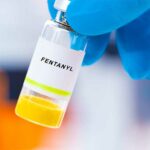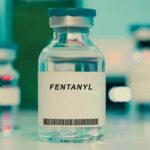Fentanyl comes in two forms, which include legal pharmaceutical fentanyl and illegal fentanyl. Both are potent, synthetic opioids that can produce dangerous depressant effects associated with an increase in overdose deaths.
The Centers for Disease Control and Prevention (CDC) reported that more than 150 people die each day from fentanyl-related overdoses. Although both forms of fentanyl have increased drug overdose deaths throughout the opioid epidemic, most fatalities are related to the illegal drug.
Pharmaceutical Fentanyl
Legal fentanyl prescriptions are used to treat severe pain or terminal cancer pain. It is available in transdermal patches, lozenges, or a shot. Fentanyl is highly potent and only prescribed if a doctor determines there is an existing tolerance to other opioids.
Illegal Fentanyl
Illicit fentanyl is manufactured in laboratories primarily in the United States and Mexico. It is sold as a powder or liquid and sometimes used as a cutting agent in illicit drugs like heroin.
Fentanyl is also associated with counterfeit pills that look like pharmaceutical drugs but contain mostly fentanyl or additives. Prescription drugs that may contain fentanyl include:
- oxycodone
- hydrocodone
- alprazolam
- methamphetamine
- Adderall
Someone using counterfeit drugs may be unaware the drug contains fentanyl, which increases the risk of overdose.
Other forms of illicit fentanyl include:
- eye drops
- nasal sprays
- blotter paper
- candies
Effects Of Fentanyl
Illicit and pharmaceutical fentanyl both activate opioid receptors in the central nervous system and provide pain relief. It may also produce euphoria along with unwanted side-effects that vary, depending on tolerance and dose of the drug.
Fentanyl may produce the following side-effects:
- drowsiness
- sedation
- constipation
- dry mouth
- confusion
- nausea
- vomiting
- dizziness
- headache
- decreased blood pressure
Fentanyl also releases dopamine and can cause changes in the brain that cause physical dependence. If you become dependent on opioids, you may experience withdrawal symptoms, like cravings, when you stop.
Dangers Of Illegal Fentanyl
Fentanyl is sometimes mixed with street drugs because only a small amount is necessary to produce powerful effects. Fentanyl may also be used to dilute a drug, like heroin, and increase profits.
Only 2 mg of fentanyl may be needed to produce a life-threatening overdose. According to the Drug Enforcement Administration (DEA), drug trafficking organizations sell fentanyl by the kilogram, which may be enough to kill half a million people.
In addition, counterfeit pills are not regulated and those that have been tested by law enforcement have been found to contain over 5 mg of fentanyl. Almost half of the pills tested contained at least 2 mg of fentanyl.
Even if you take a drug knowing it contains fentanyl, you may not know if it contains a fatal dose. The only safe way to use fentanyl is under the supervision of a medical professional.
Fentanyl Overdose
In recent years, fentanyl has played a major role in the opioid crisis. It is nearly impossible to distinguish fentanyl from other drugs, which means you can unknowingly take a drug that contains a lethal dose of the drug.
Fentanyl testing strips are available to test for the drug but they may not be reliable. Testing strips cannot determine the dose of the drug and they may not detect even more potent drugs, like carfentanil.
Carfentanil is a synthetic opioid and fentanyl analogue, which means it is a fentanyl-related compound meant to mimic its effects. However, carfentanil is about 100 times more potent than fentanyl.
If you take too much fentanyl, it can cause respiratory depression, which is characterized by shallow breathing, slow heart rate, and low blood pressure. Additional warning signs of an opioid overdose include:
- pinpoint pupils
- bluish skin tone
- gurgling sounds
- clammy skin
- loss of consciousness
If you think someone may be overdosing, call for emergency help immediately. While you wait for first responders to arrive, administer naloxone (Narcan) if you have it nearby.
Fentanyl Addiction Treatment
Under the Controlled Substances Act, fentanyl is a Schedule II drug, which means it has a high risk of abuse and dependence. Frequent drug use can lead to the development of a substance use disorder (SUD), also known as addiction.
You can recover from fentanyl addiction with the help of personalized and comprehensive treatment.
At Northeast Addictions Treatment Center, we offer a variety of opioid addiction treatment options, including partial hospitalization programs (PHPs) and intensive outpatient programs (IOPs).
If you or a loved one would like to learn more about our treatment programs, please call our helpline today.
Sources
Written by
Northeast Addition Editorial Team
©2024 Northeast Addition Center | All Rights Reserved
This page does not provide medical advice.



